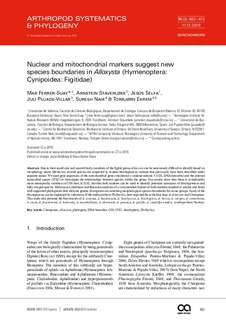| dc.contributor.author | Ferrer-Suay, Mar | |
| dc.contributor.author | Staverløkk, Arnstein | |
| dc.contributor.author | Selfa, Jesús | |
| dc.contributor.author | Pujade-Villar, Juli | |
| dc.contributor.author | Naik, Suresh | |
| dc.contributor.author | Ekrem, Torbjørn | |
| dc.date.accessioned | 2019-02-19T12:17:56Z | |
| dc.date.available | 2019-02-19T12:17:56Z | |
| dc.date.created | 2018-12-19T09:48:36Z | |
| dc.date.issued | 2018 | |
| dc.identifier.citation | Arthropod Systematics & Phylogeny. 2018, 76 (3), 463-473. | nb_NO |
| dc.identifier.issn | 1863-7221 | |
| dc.identifier.uri | http://hdl.handle.net/11250/2586265 | |
| dc.description.abstract | Due to their small size and smooth body, members of the figitid genus Alloxysta can be notoriously difficult to identify based on morphology alone. Moreover, several species are suspected to contain brachypterous variants that previously have been described under separate names. We used gene sequences of the mitochondrial gene cytochrome c oxidase subunit 1 (COI, DNA barcodes) and the internal transcribed spacer (ITS2) to investigate the relationships between species within the genus. Our results show that there is considerably more intraspecific variation in COI than in ITS2, but that both markers can be used to identify potential synonyms of brachypterous and fully winged species. Maximum Likelihood and Bayesian analyses of a concatenated dataset of both markers resulted in similar and fairly well supported phylogenies that indicate genetic divergence not matching morphological species boundaries for some groups. Some of the discrepancies can be explained by infections of the endosymbiont Wolbachia, here reported from the first time in Alloxysta and Charipinae. This study also presents the first records of A. arcuata, A. basimacula, A. brachycera, A. brachyptera, A. brevis, A. citripes, A. consobrina, A. curta, A. fracticornis, A. halterata, A. marshalliana, A. obscurata, A. proxima, A. pusilla, A. ramulifera and A. xanthopa from Norway. Charipinae, Alloxysta, phylogeny, DNA barcodes, COI, ITS2, brachyptery, Wolbachia. | nb_NO |
| dc.description.abstract | Nuclear and mitochondrial markers suggest new species boundaries in Alloxysta (Hymenoptera: Cynipoidea: Figitidae) | nb_NO |
| dc.language.iso | eng | nb_NO |
| dc.publisher | Senckenberg Gesellschaft für Naturforschung | nb_NO |
| dc.relation.uri | http://hdl.handle.net/11250/2578252 | |
| dc.title | Nuclear and mitochondrial markers suggest new species boundaries in Alloxysta (Hymenoptera: Cynipoidea: Figitidae) | nb_NO |
| dc.type | Journal article | nb_NO |
| dc.type | Peer reviewed | nb_NO |
| dc.description.version | publishedVersion | nb_NO |
| dc.subject.nsi | VDP::Zoologiske og botaniske fag: 480 | nb_NO |
| dc.subject.nsi | VDP::Zoology and botany: 480 | nb_NO |
| dc.source.pagenumber | 463-473 | nb_NO |
| dc.source.volume | 76 | nb_NO |
| dc.source.journal | Arthropod Systematics & Phylogeny | nb_NO |
| dc.source.issue | 3 | nb_NO |
| dc.identifier.cristin | 1645395 | |
| dc.relation.project | Andre: Ministerio de Economia y Competitividad FJCI-2014-21120 | nb_NO |
| dc.description.localcode | © Senckenberg Gesellschaft für Naturforschung, 2018 | nb_NO |
| cristin.unitcode | 194,31,10,0 | |
| cristin.unitname | Institutt for naturhistorie | |
| cristin.ispublished | true | |
| cristin.fulltext | original | |
| cristin.qualitycode | 1 | |
